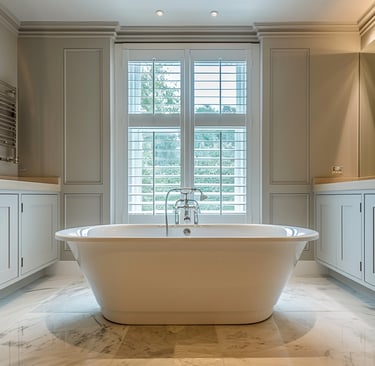Choosing Between Wooden and Composite Faux Wood Shutters
Choosing window shutters can significantly impact your home's aesthetics and functionality. Wooden shutters offer timeless charm with natural grain patterns but require regular maintenance to prevent warping and fading. In contrast, composite faux wood shutters provide modern durability, resistance to moisture, and easy maintenance. Consider factors like cost, installation ease, and environmental impact to make the right choice for your home.


When it comes to enhancing the aesthetics and functionality of your home, window shutters play a crucial role. Among the myriad options available, wooden shutters and faux wood shutters stand out as popular choices. Each material has its own set of advantages and considerations and deciding between the two is a matter of personal preference and practicality.
Wooden shutters exude a timeless and classic charm that resonates with traditional and rustic designs. The natural grain patterns and warm tones of wood create a cosy and inviting atmosphere. Many homeowners appreciate the authenticity and character that wooden shutters bring to a space. However, wood comes with its challenges, such as susceptibility to moisture and temperature changes. This can lead to warping, cracking, or fading over time, requiring regular maintenance to preserve its beauty.
On the other hand, faux wood shutters offer a modern and practical alternative. Composed of synthetic materials like PVC, these shutters are engineered to withstand various environmental conditions. Vinyl shutters are resistant to moisture, making them an ideal choice for humid climates where traditional wood may struggle. They are also highly durable, with minimal maintenance requirements. Cleaning is a breeze – a simple wipe with a damp cloth is often sufficient to keep them looking brand new. Additionally, vinyl shutters are available in a wide range of colours and styles, providing flexibility to match any home's design aesthetic.
One of the key considerations when choosing between wooden and vinyl shutters is the cost. Wooden shutters tend to be more expensive upfront and the ongoing maintenance costs should also be factored in. While the initial investment in vinyl shutters is typically lower, it's essential to weigh the long-term durability and maintenance savings against the upfront cost difference.
Installation is another factor to consider. Wooden shutters, being heavier, may require more substantial hardware and professional installation. Vinyl shutters, being lightweight, are often easier to handle and install, making them a more DIY-friendly option for homeowners looking to save on installation costs.
Environmental considerations may influence your decision as well. Wooden shutters, if sourced from sustainable forests, can be considered an eco-friendly option. However, the manufacturing and treatment processes may involve chemicals and energy consumption. Vinyl shutters, while not biodegradable, can be recycled, and some manufacturers offer environmentally conscious options.
In conclusion, the choice between wooden and composite vinyl shutters ultimately depends on your priorities and preferences. If you value the timeless beauty of natural wood and are willing to invest time in maintenance, wooden shutters may be the right choice for you. On the other hand, if durability, low maintenance, and a diverse range of styles are your priorities, faux wood shutters could be the perfect fit. Whichever option you choose, investing in quality shutters enhances your home's curb appeal and provides a lasting impact on both aesthetics and functionality.
